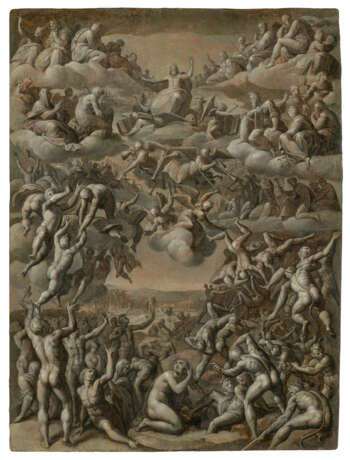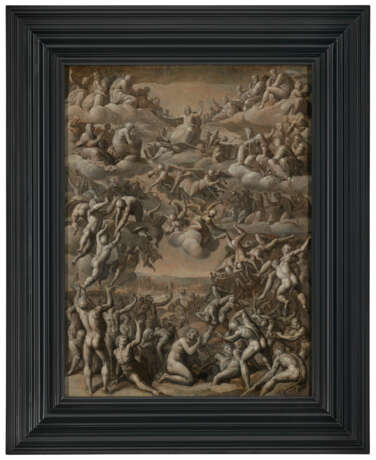ID 974645
Lot 13 | JACOB DE BACKER (ANVERS 1560-1590/1591)
Valeur estimée
€ 20 000 – 30 000
Le Jugement dernier, grisaille
huile sur papier contrecollé sur panneau
57,2 x 42,8 cm. (22 1/2 x 16 7/8 in.)
porte trois cachets héraldiques en cire, un d'Alexandre Dimitrievitch Lanskoï (voir infra), deux non identifiés (au revers du panneau)
Provenance
Collection d'Alexandre Dimitrievitch Lanskoï (1758-1784), Saint-Pétersbourg (selon un cachet de cire au revers du panneau).
Collection particulière, Munich.
Vente anonyme, Kastern Kunstauktionen, Hanovre, 28 septembre 2013, lot 114.
Vente anonyme, Sotheby's, New York, 29 janvier 2014, lot 4.
Literature
J. Müller Hofstede, 'Jacques de Backer: Ein Vertreter der Florentinisch-Fömischen Maniera in Antwerpen', Wallraf-Richartz-Jahrbuch, XXXV, 1973, p. 239, reproduit en noir et blanc p. 231, Abb. 6.
E. Leuschner, 'A Grisaille Oil Sketch from the "De Backer Group" and Workshop Practices in Sixteenth-Century Antwerp,' Metropolitan Museum Journal, 2008, 43, p. 102.
Special notice
These lots have been imported from outside the EU for sale and placed under the Temporary Admission regime.
Import VAT is payable at 5,5% on the hammer price. VAT at 20% will be added to the buyer’s premium but will not be shown separately
on our invoice.
Post lot text
JACOB DE BACKER, THE LAST JUDGEMENT, GRISAILLE, OIL ON PAPER LAID DOWN ON PANEL
This spectacular grisaille was identified in 1973 by Justus Müller-Hofstede (J. Müller Holfstede, 1973, op. cit. supra) as the modello of the central panel of the famous Last Judgement triptych, executed in 1591 in memory of the Antwerp printer and publisher Christophe Plantin (c. 1520-1589), whose tomb in the ambulatory of the choir of the Onze-Lieve-Vrouw Cathedral in Antwerp this painting was to decorate. The triptych was seized by Napoleon's armies at the beginning of the nineteenth century, but was later restored and is now preserved in its original location.
All the main elements of the composition of the central panel of the triptych are visible in the modello. However, there are some changes visible between the details and those of the final work, which testify to the preparatory nature of the present painting.
In the triptych in Antwerp Cathedral, the dramatic scene of the Last Judgement is flanked by two panels depicting the donors: Christopher Plantin kneels at a prie-Dieu on the left-hand panel, accompanied by his young son, also named Christopher. Their patron saint is shown behind them, carrying the Christ Child on his shoulders. The printer's wife, Jeanne Rivière, also kneeling before a prie-Dieu, is shown on the right-hand panel with the couple's six daughters. Her patron saint, St. John the Baptist, points to the sacrificial lamb; placed behind the kneeling figures, this grouping reflects the composition on the left-hand panel.
Although there is no trace of the commission for this triptych, and consequently no proof of the author of these panels, the Last Judgement scene was attributed in 1763 to the Antwerp painter Jacob de Backer (1560-1590/1591) (E. Leuschner, 'Defining de Backer. New Evidence on the last phase of Antwerp Mannerism before Rubens', Gazette des beaux-arts, 2001, 137, 1587, p.189).
A little-known artist, none of the works mentioned as by his hand by Carel van Mander (1548-1606) in Het Schilder-Boeck (1604) have been concretely identified today. Although it is clear that a distinct artistic personality is behind the central panel of the cathedral triptych, as well as other representations of the Last Judgement, such as the one in the Antwerp Museum of Fine Arts (inv. no. 653) dated 1571, all executed in a distinct Italo-Nordic Mannerist style, the attribution to Jacob de Backer is ultimately more traditional than affirmed. This has led Prof. Dr. Eckhard Leuschner to publish the painter's works as part of the corpus of the "De Backer Group" rather than giving them to the artist himself (E. Leuschner, 2001, op. cit. supra).
The catalogue entry for the 2014 sale nevertheless specifies that Prof. Dr. Leuschner indicated that the modello was of high quality and could be related to the Last Judgement in Antwerp Cathedral. On the basis of the current attribution of the central panel of this triptych, which has been supported since the eighteenth century, it is quite reasonable to attribute the present painting to the same hand, that of Jacob de Backer.
In addition to the artistic qualities of this modello, this painting is a rare and early example of a type of grisaille oil sketch that would gain in popularity a few decades later, becoming an integral part of the practice of painters' studios – like that of Peter Paul Rubens (1577-1640) – in the Southern Netherlands, as they saw it as a medium both informing and controlling the engravers responsible for reproducing their works.
| Artiste: | Jacob de Backer (1555 - 1585) |
|---|---|
| Technique appliquée: | Huile, Peint |
| Matériel: | Verre acrylique, Papier, Plastique |
| Style artistique: | Vieux Maître |
| Lieu d'origine: | Belgique, Europe de l'Ouest, Europe |
| Catégorie maison de vente aux enchères: | Peintures |
| Artiste: | Jacob de Backer (1555 - 1585) |
|---|---|
| Technique appliquée: | Huile, Peint |
| Matériel: | Verre acrylique, Papier, Plastique |
| Style artistique: | Vieux Maître |
| Lieu d'origine: | Belgique, Europe de l'Ouest, Europe |
| Catégorie maison de vente aux enchères: | Peintures |
| Adresse de l'enchère |
CHRISTIE'S 9 Avenue Matignon 75008 Paris France | ||||||||||||||
|---|---|---|---|---|---|---|---|---|---|---|---|---|---|---|---|
| Aperçu |
| ||||||||||||||
| Téléphone | +33 (0)1 40 76 85 85 | ||||||||||||||
| Fax | +33 (0)1 40 76 85 86 | ||||||||||||||
| Conditions d'utilisation | Conditions d'utilisation | ||||||||||||||
| transport |
Service postal Service de messagerie ramassage par vous-même | ||||||||||||||
| Modes de paiement |
Virement bancaire | ||||||||||||||
| Heures d'ouverture | Heures d'ouverture
|






